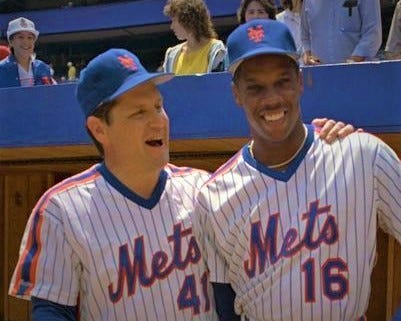Dwight Gooden Remembers Tom Seaver
Q&A: Tom Seaver, the greatest Met of all-time, died on Monday. Dwight Gooden took a few minutes to reflect on a childhood idol and eventual mentor.

-Photo via @DocGooden16
Tom Seaver, the greatest player in Mets history, died on Aug. 31 due to complications of Lewy body dementia and COVID-19. He was 75.
A three-time Cy Young winner, 300-game winner and Hall of Famer, Seaver was instrumental in delivering the Mets their first World Series championship in 1969. He spent 12 seasons over two stints in New York while also pitching for the Reds, White Sox and Red Sox. His playing career spanned two decades.
The season after Seaver’s last with the Mets, a new dominating right-hander by the name of Dwight Gooden debuted in blue and orange. Like Seaver, Gooden experienced instant success, plenty of hardware and a short wait for a championship. “Doc” didn’t enjoy the same longevity that “Tom Terrific” did, but if Seaver is the best pitcher in Mets history – and he is – there is a strong case to be made for Gooden at No. 2.
The two were never big league teammates, but that didn’t stop the Mets legends from forming a relationship. Following the announcement of Seaver’s death on Wednesday, Gooden spent some time talking to The Changeup’s Gary Phillips about No. 41’s impact on him.
Gary Phillips: I know this is a big loss for the Mets family. What did Tom Seaver mean to you and how did your relationship with him evolve over the years?
Dwight Gooden: Tom was like a mentor. Him and Nolan Ryan were my two childhood idols... I watched a lot of their games with my dad and I remember being in the backyard pretending to be either Nolan Ryan or Tom Seaver playing against my nephew, Gary Sheffield. We grew up in the same house. We used to pitch against each other, and we would argue who's going to be Tom Seaver that particular day, who was going to be Nolan Ryan.
When I got to meet Tom, we had great conversations. We loved talking about pitching, sequences, how we set hitters up... What are you doing when there's no season or it's not spring training to make yourself better? We talked a lot about family, health, things that matter... He was just a great guy all around. Everyone knew he was a great baseball pitcher, but to me, he was an even better person. He was always in a good mood, always ready to talk baseball, always upbeat.
GP: You said in your statement to the Mets that Seaver was one of the first people to call you after you won your Cy Young award in 1985. What do you remember about that phone call?
DG: He just congratulated me and said, "Welcome to the club."
He said, "Make sure when the league comes after you... just be prepared. Don't try to top the season you had. Just try to duplicate the season you had and you'll be fine." He was just always, always upbeat and a genuine guy.
GP: Seaver played his last game for the Mets the year before your rookie season, so you guys never got to be teammates at the big league level. Did your paths ever cross when you were a Mets minor leaguer?
DG: I came to New York a little bit in 1983 for an exhibition game where we played the Padres' A-ball club and, before one of the games, we talked.
We always talked about what it would have been like to play together. For me, that would have been an absolute dream come true. As a kid, he was my idol. Just the knowledge he had. He always kidded, "With the knowledge I have and the talent you have, we put that together, man who knows where it can get you!" But we always had a lot of good talks. He tried to make a comeback [in 1987]... It didn't go too well and he ended up retiring. I remember in 1986 he was on the Red Sox during the World Series, but it didn't seem right. It just felt like he was supposed to be in our dugout.
GP: That first time meeting him in '83, at that point he's already a World Series champion, he's “The Franchise,” he's established as this great Mets player. And you're this up and coming pitcher with high hopes. What was that moment like for young Dwight Gooden?
DG: For me it was surreal… I told him, "Man, it's a pleasure to meet you." It was like being a little kid talking to your idol. I couldn't believe it.
He said, "I'd like to see you up here real soon" and be teammates. That was always the goal. He said, "keep working hard, don't take no starts for granted and you'll be fine." I was listening to him talk and I was in awe. I couldn't wait to get back to my hotel to call my friends and tell them, "You're not going believe it! I had a conversation with Tom Seaver!" All my friends knew how much I loved him.
GP: As we're talking, the Yankees and Mets are playing and every Met has a dirty right knee as a tribute to Seaver's drop and drive delivery. That’s such a uniquely Tom Seaver thing. What will you remember most about him, whether it be as a player or person?
DG: The way he carried himself as a ballplayer on and off the field. He was a true gentleman. I never heard anything bad about him... He always found time to sign autographs for kids, for everyone. On the field, his teammates loved him. He had a bulldog mentality on the field and off the field, he was as kind as you can be. He led by example. He did it the right way. He didn't have to say, "do this" or "do that." He actually led by example. He was what you call a quiet leader. He wasn't a ra-ra guy, but just watching him and the way he prepared, the way he trained – he kept himself in top condition... That's why they call him “The Franchise.” He led by example.
GP: What's the most important thing you took from him as a pitcher?
DG: The main thing was not just as a pitcher, but as a professional player, just understanding that it's always a privilege to wear a big league uniform and play in the major leagues. He told me to remember that because so many different people would love to have the opportunity to be in the situation you're in... That's one thing that always stuck with me and that's something I still share with the younger generation of baseball players.
GP: Seaver’s number was retired and he was inducted into the Mets Hall of Fame a while back. Then, last year, the Mets changed Citi Field’s address to 41 Seaver Way and announced plans for a statue, but he was already sick at that point and unable to attend the ceremony. I know a lot of people have opinions on this, so do you think the Mets have done a good job recognizing Seaver’s legacy and importance to the franchise over the years?
DG: That's a great question. Me, personally, I would like to see more. Not just for Seaver, but other players as well. But just the fact that they are doing it – unfortunately he won't be around to see it – but it's something that his kids or his grandkids will always get to go see and share with their kids if they're ever in New York. It's something that will always be here.
Every organization is different. Me, personally, yes. As a fan of Tom's – I might be a little biased – I'd like to see more. But the fact that they are doing it, I think that's great. His family can always share that and feel like they're part of him and his history and what he did at Shea Stadium.
*Editor’s Note: This interview has been edited for clarity and length.
Gary Phillips is a reporter, writer and editor for hire. He has written for The Athletic, Sporting News, USA Today Sports, Bleacher Report and Yankees Magazine, among others. He can be reached at garyhphillips@outlook.com.
Like what you read? Be sure to share and subscribe to The Changeup in order to get articles sent straight to your inbox!





